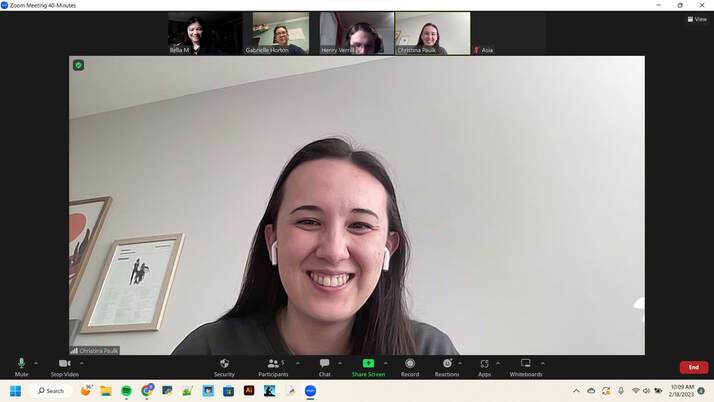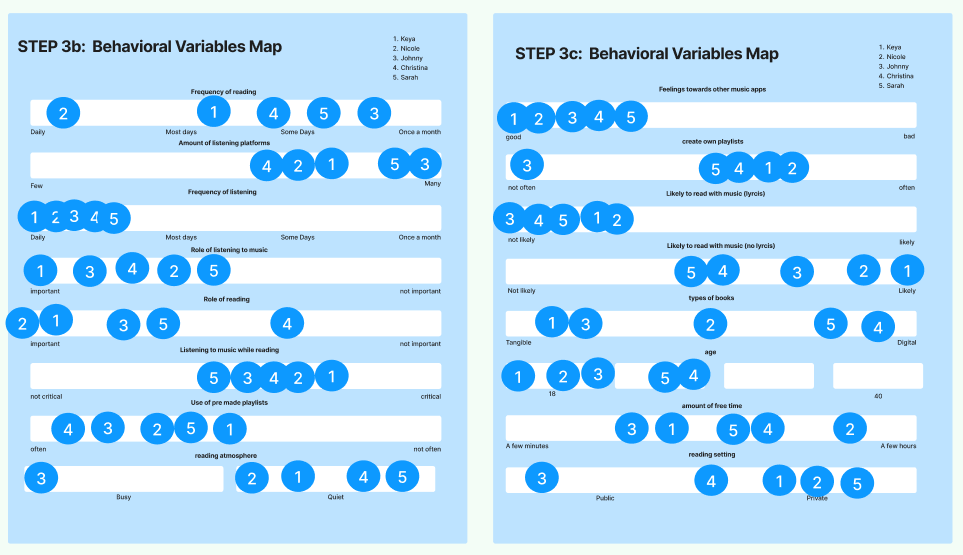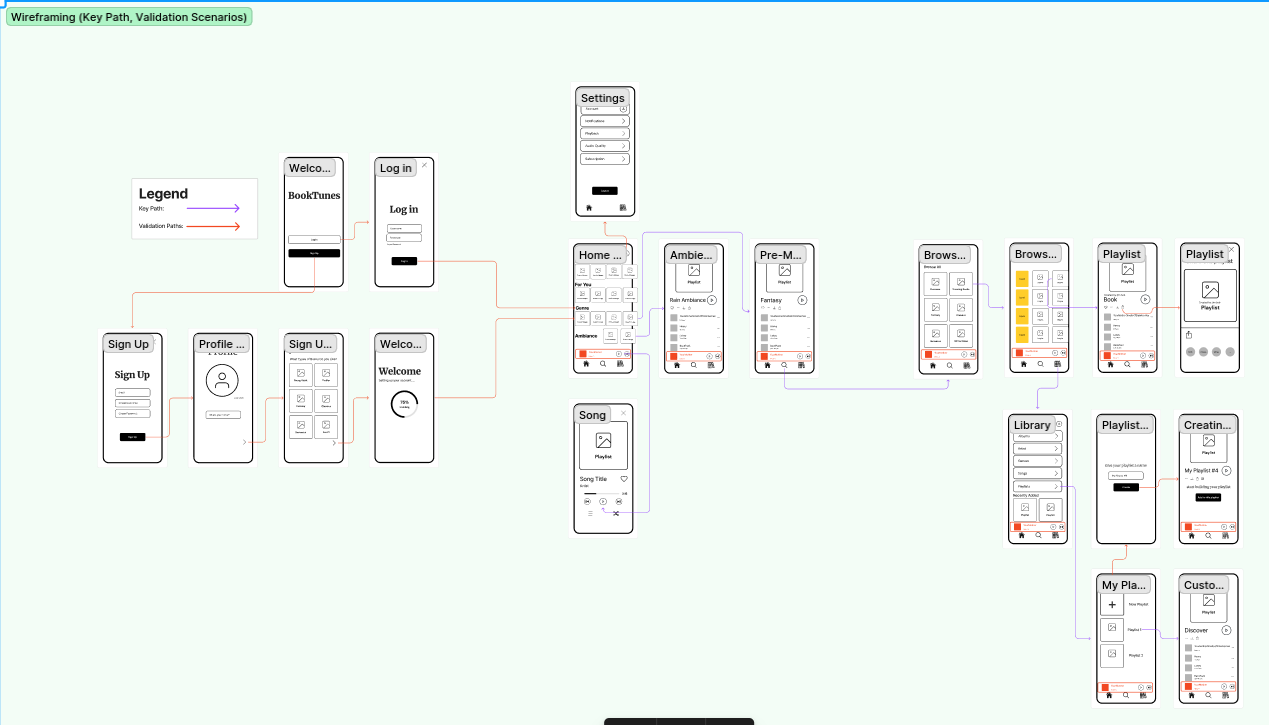Booktunes Design Process

Executive Summary
| Approach: Goal Directed Design | Objectives: Make a working app prototype in figma. |
|---|---|
| Team Size: 4 | Tools: Discord, FigJam, Figma, Canva |
| App Idea: A book recommendation and music player app. | Role: Team Member, Component Creation |
| Duration: 4 months | Links: Figma Prototype Research Report |
Introduction
This project was titled Booktunes. The concept behind booktunes is to make it easy for readers to find playlists and songs that match the "vibe" of the book they're reading. If you're reading Lord of the Rings, the music might be tense and epic. If you're reading Harry Potter, the music might be wondrous with strings.
To design the app prototype, we used a process called Goal Directed Design, or GDD. As it was a class settings, our team leader was the creator of the idea, so the requirements phase was dropped to fit within a 16-week course.
My team members each have their own portfolio websites. See them below:
The rest of this page is organized by the GDD phases in order. See the method section below for a overview of GDD.
Method
GDD, or Goal Directed Design, was created by Alan Cooper, and is detailed in his book 'About Face – The essentials of interaction design'. The method is a behavior and evidence-based design process that uses research to create a fictional "persona", or average user, and then use that persona to create a robust application that fulfils the persona's requirements. (Cooper et al., 23)
As mentioned earlier, our team leader was the creator of the idea, so the normally included requirements phase was dropped.
Adapted GDD Phases
| Phase 1 | Phase 2 | Phase 3 | Phase 4 | Phase 5 |
|---|---|---|---|---|
| Research | Modeling | Requirements | Framework | Refinement |
Research Phase
The Research Phase is all about collecting data, and is the most extensive phase of Goal Directed Design. In the research phase, you look at competitors, review research literature, interview potential users, and talk with stakeholders.
Kickoff Meeting
Since there were no stakeholders besides our team leader Bella Margiano, we simply filled out a kickoff worksheet, which allowed us to make a problem statement and assumption statements to predict the direction the project will go. The problem statement defines the purpose of the project and the status quo it seeks to change.
Problem Statement
The current state of the BookTunes industry lacks a niche-related app that focuses on readers and enhancing the reading experience and has focused primarily on the general generic use of listening to music. What existing products/services fail to address is the desire from readers for an app that offers playlist and music that corresponds with books. Our product/service will address this gap by capitalizing on this niche market by offering readers a central music hub with playlists that correspond with different books and genres.
Literature Review
The literature review is part of the research phase that involves searching for literature discussing the status quo of our problem statement, potential features, potential users, industry statistics, and other useful metrics. We had a few key takeaways:
- Young adults read more than any other age group.
- Streaming services are already pushing custom playlists based on popular books.
- Streaming apps are a hot market right now, and is expected have room to exponentially grow.
- A community on TikTok called "BookTok" commonly recommends playlists, artists, and other music to best pair with a book or series.
Competitive Audit
The competitive audit is where we examine the predicted competitors for Booktunes and analyze their products. Since Booktunes is a streaming application but also a book recommendation app, we looked at streaming services like YouTube, Spotify and Apple Music, as well as reading recommendation websites like Goodreads.
The audit covers many details and attributes of the competing apps, such as price, popular features, their best attributes, and their downsides. We found that a lot of the popular features could be replicated in our own app, and the bad features could be tackled with different design decisions or by taking a different approach. As with all research, not everything was useful, but we came away with a lot of ideas for features.
Stakeholder Interviews
As mentioned earlier, we do not have a real client, so the only stakeholder was our team leader, Bella Margiano. To simulate an interview, our team used the assumption statements from our kickoff meeting worksheet. We had a few takeaways:
- Our target audience is people who enjoy reading.
- The app should be easy and seamless to use alongside a user's daily life.
- Users will select a playlist that is related to the book they are reading and listen to it while doing so.
- A variety of playlist types are available: lyrical, no lyrics, colored noise, or user-created playlists.
- The product should increase immersion and suppress boredom while reading.
- The primary value a use gets from the app is setting the mood for reading and increasing immersion.
User Interviews
The final step of the research phase is to conduct user interviews. We first created a persona hypothesis, which defined the kind of people which might use the app. We used this persona hypothesis to select a number of volunteers from the university book club or writing club.
We conducted five interviews. Three were online, using either using Discord or Zoom. Two other interviews were conducted in person. I took notes for two of the virtual interviews, and conducted one of them.

After the interviews concluded, we used affinity maps to take notes and organize our thoughts into distinct categories. This allowed us to spot patterns and analyze the results of the interviews. We ended up finding a few patterns between interviewees:
- How often they read
- Where they read
- How they discover new books
- What role music plays in their daily life
- The apps they use for streaming music
Modeling Phase
This phase is all about taking our raw research data and turning it into a persona. The first step is to take data points from the interviews and plot them on a behavioral variables map.

Next, we go over the behavioral variables map and identify behavior patterns by circling dots that are grouped together.

Finally, we take these behavior patterns and create a fictional character profile based on them in aggregate. This profile is called a persona. The persona will operate as our average user, and future design decisions will be based solely on this persona and it's goals. It's important to note that a persona isn't real, but they are assembled from the thoughts, feelings, behaviors, and motivations of real people.
Alan Cooper makes note of the role of personas in his book 'About Face'. “Personas provide us with a precise way of thinking and communicating about how groups of users behave, how they think, what they want to accomplish, and why.” (Cooper et al., 62)

Requirements Phase
The requirements phase is all about creating a list of requirements from our newly created persona and brainstorm what the end result might be like. The first step for this was to create a problem statement and a visions statement.
Problem Statement
The current state of the BookTunes industry lacks a niche-related app that focuses on readers and enhancing the reading experience and has focused primarily on the general generic use of listening to music. What existing products/services fail to address is the desire from readers for an app that offers playlist and music that corresponds with books. Our product/service will address this gap by capitalizing on this niche market by offering readers a central music hub with playlists that correspond with different books and genres.
Vision Statement
The new design of music a streaming app will help users achieve their goal of reading more by allowing them to find music that corresponds well with their books creating a relaxing reading environment with greater efficiency, and without problems of interruptive ads, inaccurate recommendations, and repetitive recommendations that they currently experience. This will dramatically improve BookTunes’ customer satisfaction ratings and lead to increased market share.
After creating the Problem and Vision statements, we created what is called a context scenario, which tells a story from the perspective of our persona and a day in their life while using Booktunes.

Finally, we created the requirements list based on our context scenario. We tracked all of the actions, objects, and contexts which appeared in the context scenario, and refined them into a list of required features and object for the app prototype to have.
Requirements List
- Access (action) pre-made playlist (object) on home screen (context)
- Streams (action) custom playlist (object) from app library (context)
- Press (action) pause button (object) to stop the music (context)
- Explore (action) for new book (object) on book recommendation section of the search page
- Streams (action) book title playlist (object) made by another user from search page (context)
- Creates (action) custom book title playlist (object) in app library (context)
- Explores (action) genre categories (object) on search page (context)
- Streams (action) ambient radio (object) as background noise on home page(context)
- Shares (action) custom playlist (object) with friend over message (context)
Frameworks Phase
Before instantly jumping to the final, high fidelity prototype, we created a low-fidelity wireframe in FigJam based on our requirements. If we had jumped ahead, we would be lost when creating the prototype. The prototype is all about the details and fleshing out the idea, whereas the wireframe is for organizing the paths and making sure they flow well. We used two different colored arrows to distinguish between different scenarios.
The purple arrows represent Key Paths, which describe a user's most commonly used paths. The orange arrows represent Validation Paths, which are paths that are used very infrequently, or only once.

The wireframe allows us to visually represent the persona's goals and requirements. In doing the wireframe, we discovered what we needed more screens than anticipated. If we had skipped to prototyping, we would have been blindsided.
Refinement Phase
The refinement phase is all about taking a "rough draft" of the prototype and conducting usability testing to detect issues, inconsistencies, easily misunderstood elements, and other problems that would have caused a bad experience to users or degrade the quality or functionality of the app. In our case, we had two different participants each use our prototype. They were each asked to complete a number of tasks within the app and rate it's difficulty from 1 to 5, and then elaborate on their thoughts and feelings regarding the task.

After each usability test, we made brief changes to improve our prototype before the next one. After this concluded, we continued working on the prototype until we deemed it completed.
Conclusion
Goal Directed Design is a fantastic design method. It uses actual research and evidence to create a product, rather than just guessing or conducting usability testing at the last minute. If I could do this project over again, I would have communicated with my team better, and perhaps contributed to the research report more. User feedback during the refinement phase was immensely helpful, and spurred us to change many things, such as changing the alignment of the back arrows on each page, and changing the "perfect pairs" page to be easily readable. This project was a valuable experience for me in both teamwork and in learning the fundamentals of interaction design.

Works Cited
Cooper, Alan & Robert Reimann, David Cronin, Christopher Noessel. 2014. About Face: The Essentials of Interaction Design, 4th Edition. Hoboken, NJ: Wiley Press.